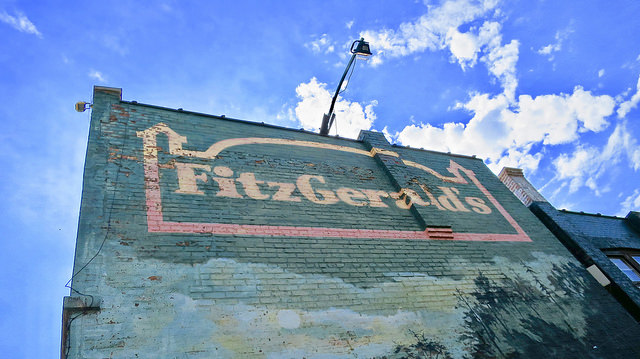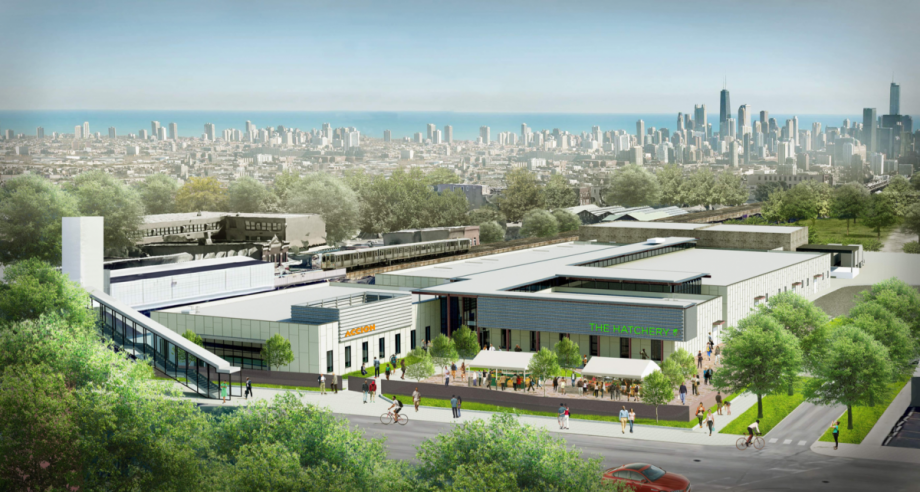
Aug 11, 2017
Julia Kramer | Bon Appetit | August 8th, 2017
I don’t own a single piece of Cubs paraphernalia. I don’t have Chicago’s four-star flag tattooed on my forearm. I don’t care if you put ketchup on a hot dog. But there’s one thing from my hometown that I will absolutely go to bat for, and here it is: Chicago is clearly America’s most exciting city to eat in right now.
As a Chicago native who covered the city’s food scene for years as a local restaurant critic, I’m obligated to tell you that my hometown has always been able to hold its own against the best food cities in the country. But I can’t remember a time that I’ve been as psyched to eat there as I’ve been this year. Where other cities fall into soulless trend cycles, Chicago has a way of generating distinctively personal restaurants. So, SF and L.A., this might hurt a little, but here’s all the proof you need that the Midwest is best.
1. Dessert Comes First
Sweets as beautiful as works of art are nothing new. The problem is that they often taste as good as eating an actual canvas. What makes Anna Posey’s desserts at Elske (one of our Top 50 Best New Restaurants in America) unusual is that they’re so modern-looking and visually arresting that they could exist only in 2017—and yet they’re as simply pleasurable to eat as a classic slice of pie. The only challenge posed to the desserts at Elske is that the rest of the menu, from Anna’s husband, David—the former chef of Blackbird—is equally impressive: Every dish has a clean, contemporary look without sacrificing deliciousness.
2. A Suburban Food Court Is One of the Most Exciting Places to Eat
The International Mall in Westmont, Illinois, 22 miles from downtown Chicago, is more or less your typical suburban food court—fluorescent lighting, drop ceilings, and all—with stands selling inexpensive dumplings on Styrofoam plates. Right in the middle of it is Hanbun, a hidden gem run by a remarkably talented young chef, David Park, and his fiancée, Jennifer Tran. At lunchtime, the stand serves bibimbap and rice cakes and bulgogi. The food’s great, but it doesn’t prepare you for what’s to come in the evenings, when Park throws down a white tablecloth and serves a single group of six diners the “juhnyuk tasting,” a seven-course menu that refracts the foods of his Korean-born, New Jersey–raised upbringing through the techniques he accrued working the line at fine-dining spots in Chicago. The dinners have become so popular that Hanbun is booked up through the end of its lease in May 2018, but there’s no doubt that wherever Park goes next, it’ll become another destination.
3. This City Still Owns Fine Dining
All you really need as evidence is Alinea’s recent reboot. But ask any (food-obsessed) local to name his or her top openings, and you’re likely to hear about a life-changing meal at John Shields and Karen Urie Shields’ Smyth(another one of our Top 50 Best New Restaurants in America). The Shieldses met working at the legendary dining institution Charlie Trotter’s and returned to town after an acclaimed stint at Town House in Chilhowie, Virginia. Thoughtful five-, eight-, and 12-course tasting menus filled with eclectic produce grown specifically for the restaurant are served upstairs at Smyth; an instantly iconic burger (with bacon in the patty) brings in an after-work crowd to The Loyalist pub downstairs. What could more perfectly sum up Chicago dining than that?
CONTINUE READING

Aug 5, 2017
Steve Johnson | Chicago Tribune | August 4th, 2017
When Bill FitzGerald started going to the music venue that became FitzGerald’s, there were deer heads and velour on the walls and Herb Alpert and classic country on the jukebox, and the owners lived in the room behind the stage that is now FitzGerald’s office and the dressing room for the bands.
He was an Oak Park house painter and music club habitue in his late 20s. But on the first day of 1980, at a brunch with friends and family, he said, “Wouldn’t it be fun to own a bar and have music?” He had heard that the Berwyn place, then known as the Deer Lodge, was for sale and he later learned the price was right: $60,000.
FitzGerald was taking this trip down memory lane the other night because he is on the verge of another transition. After one more successful American Music Festival, the club’s Fourth of July weekend tradition that is the longest-running independent music fest in the city, FitzGerald, who’ll be 65 in a few months, announced that he’ll be stepping down as the club’s talent buyer, the person who books the bands to come and play, in favor of 30-year-old Donnie Biggins.
It seemed like the end to an era in its own right: No longer would patrons be able to count on the avuncular, white-haired presence of FitzGerald, the guy you’d see fiddling with the soundboard, shushing overly talkative patrons, roaming intently through a crowded room on his way to another of the mystery missions that keep a music club going.
But there was more to it than that. FitzGerald and his family, he has decided to say publicly for the first time, have also determined that it’s time to get out of the business altogether. FitzGerald’s Nightclub — a nearly four-decade fixture on Roosevelt Road and on the American roots music scene and a club the roots musician Dave Alvin, who is legendary himself, describes as “legendary” — is for sale.
FitzGerald and his family have hired a broker, Tim Rasmussen of SVN Restaurant Resource Group, the same guy who successfully sold Schubas and Lincoln Hall a couple of years ago. And Rasmussen has been offering the property quietly, at least until now.
He is optimistic, he said, but he knows it’ll be a challenge. “It’s not like selling a restaurant in Lincoln Park or the West Loop,” he said. “You have to thread the needle and find somebody that’s got a love of the music … and appreciates what they’ve built over the last 37 years. I liken it to selling a piece of art or an antique. Its value isn’t just in the financial performance or the underlying real estate assets. It’s the totality, kind of the cultural thing that it provides the city.”

Aug 2, 2017
Lauren Thomas | CNBC | July, 17th 2017
Amazon, whose plans to acquire supermarket chain Whole Foods pose a threat to the grocery industry, appears to be entering the meal-kits business.
Amazon registered a trademark in the U.S. on July 6 for a service described as: “We do the prep. You be the chef.” The service will provide customers “prepared food kits … ready for cooking and assembly as a meal,” according to the trademark application.
The kits will primarily consist of grains, rice, noodles, pasta or bakery products, Amazon said.
The Times, a British-based publication, first reported this news Sunday.
This fresh ambition by Amazon will no doubt threaten meal-kits provider Blue Apron, which just recently listed on the public market.
Representatives from Amazon and Blue Apron didn’t immediately respond to CNBC’s request for comment.
Blue Apron holds the title as the largest meal-kit provider in the U.S., followed by German-based HelloFresh.
Since its initial public offering, though, shares of Blue Apron have tumbled. Just last week, the stock closed at a new low after an analyst slapped Blue Apron with a $2 price target, citing difficulty with the business ever becoming profitable. Blue Apron’s stock closed Friday at $7.36 per share, down nearly 10 percent for the week.
On Monday morning, Blue Apron’s stock was falling more than 10 percent, hitting an all-time-low below the $7 mark.
CONTINUE READING

Jul 22, 2017
Oscar Perry Abello | Next City | July 19, 2017
Angela Taylor has been helping her neighbors grow food for years on the west side of Chicago. Soon, she’ll be helping some of them grow food businesses.
Taylor learned how to grow stuff at a young age. “Me being the youngest girl, I didn’t get to do the laundry and other chores inside,” she remembers. “I had to go outside and help daddy with the gardening.”
She and her husband moved into their current home, in the East Garfield Park neighborhood, in 2004. There was an abandoned community garden next door, covering two city lots, with raised beds.
“Right in front of where the garden had been [was] a notorious zone for the drug traffic,” Taylor recalls. “They sat in front of the garden on milk crates selling drugs all day and all night.”
She and her sisters cleaned up the space and put it back into use. It’s become the hub of the Garfield Park Community Council’s Community Garden Network, with 32 resident-led gardens scattered throughout East and West Garfield Park. Each garden provides some fresh fruits and vegetables for the gardeners, their families and neighbors, and the rest gets sold at the council’s bimonthly Neighborhood Market, which accepts food stamps as payment. “I’m sure you know we’re living in a food desert, and there is a lack of fresh produce,” says Taylor, who retired in 2012 from the Illinois Department of Human Services.
Taylor’s garden now has a rainwater catchment and irrigation system, and a community greenhouse with solar-powered heating and lighting. Every growing season, the garden network takes seedlings from the greenhouse to get started, and there’s enough left over to share with gardeners from other neighborhoods. There’s no more drug trafficking out front.
“When I first moved in, the seniors on my block wouldn’t even come out and sit on their porch because of all the drug trafficking,” Taylor adds. “But go there now and they’re sitting on their porch, some of them are taking naps, because now they feel safer in that type of environment. There’s not too much more to be said about that.”
Taylor hopes that The Hatchery, a brand-new, 67,000-square-foot food business incubator coming to the neighborhood, may have a similar effect on a much larger scale.
CONTINUE READING

Jul 14, 2017
CIT | 5/16/16
So you need financing for your restaurants? Just like packing for a trip, you need some standard items – things to keep in mind before you pick up that phone.
There are a host of macro and microeconomic (or top down vs bottom up) reasons lenders like extending credit in the restaurant franchise space. One reason is industry growth. According to the USDA, the percentage of total food expenditures outside the home has grown from 26.3% in 1960 to 49.6% today, even though the per capita percentage of disposable income allocated to food has declined in relative terms. In fact, Americans spent more money at restaurants than at grocery stores last year for the first time since the Census Bureau started tracking that information in 1992. When times get tough, diners simply respond by trading down instead of staying home. And when Americans start saving elsewhere, like with currently low gas prices, restaurants are among the biggest beneficiaries.
While chain restaurant investments provide for attractive opportunities both to lenders (i.e., debt side) and owner/operators (i.e., equity side), they are not without risk. In the absence of hard collateral to backstop financing, lenders have to accurately assess Enterprise Values and whether a franchise borrower group will create enough free cash flow (defined as EBITDA less G&A allocation and capex captured in the P&L) to cover their annual debt servicing requirements for an acquisition, remodeling, new location, or other funding need. Multiple factors weigh into the lender’s credit decision, such as:
1. Sector Trends
Which of the main restaurant categories – full service, quick service, fast casual, and snack – are in growth mode and which are in decline? Is the Franchisor responding to, driving, or missing market changes and demands? There are always winners and losers. Although sector shifts don’t happen overnight, most lenders take an extended view regarding portfolio performance, which extends years or even decades and must be cognizant of broad trends. Other considerations such as labor laws, supply-side input costs, demographics, household income trends, and interest rates will factor into a lender’s overall assessment of the sector.
2. The Brand
How is the system performing based on key metrics such as Same Store Sales, average unit volumes, COGS & Labor expenses and operating margins, and expected unit-level EBITDA? Is the concept performing above or below industry averages? Is the P&L insulated or susceptible to material input or COGS changes? How does the franchisee’s performance over the past three years stack up against these benchmarks?
CONTINUE READING





